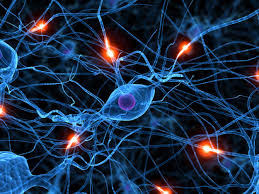Instruction: pick the one best answer. This is also useful on the USMLE step 1.
1. Which of the following is a supporting cell found in the ganglia?
a. Schwann cells
c. Ganglion
d. Neuroglia
e. Satellite cells
Answer: e
Schwann cells are responsible for the myelination of neurons in the peripheral nervous system. Basket cells are a type of neuron seen in the cerebellum. A ganglion is a collection of nerve cell bodies outside of the CNS. Neuroglia are the supporting cells in the central nervous system Sometimes, neuroglia called glial cells or glia. Satellite cells are found in the ganglia of the peripheral nervous system.
2. Which of the following is an element of the central nervous system?
a. Receptors
b. Brachial plexus
c. Brain
d. Ganglia
e. Sciatic nerve
Answer: c
The central nervous system consists of the brain and spinal cord. All other nervous system elements are considered to be in the peripheral nervous system. Thus the peripheral nervous system includes receptors, the brachial plexus, the sciatic nerve, and ganglia.
3. What are interneurons?
a. Unipolar
b. Pseudounipolar
c. Bipolar
d. Multipolar
e. Both a and b
Answer: d
Interneurons are multipolar.
Neurons can be classified based on the number of axons and dendrites stemming off of the cell body. A unipolar neuron has one process which branches off of it This process then immediately divides into two. Thus, a unipolar neuron is sometimes also called a pseudounipolar neuron. Sensory neurons are unipolar.
A bipolar neuron has two process that branch from it: an axon and a dendrite. Bipolar neurons are not very common and are found in some of the organs for special senses. Bipolar neurons are found in the retina, inner ear, and the region of the nose involved with smell.
Multipolar neurons have one axon and many (at least two) dendrites that branch off of it. Most neurons are multipolar. Motor neurons and interneurons are multipolar.
4. Which of the following is supporting cell of the central nervous system?
a. Ganglion
b. Perikaryon
c. Astrocyte
d. Nissl
e. Terminal bouton
Answer: c
A ganglion is a collection of neuron cell bodies outside of the central nervous system. The cell body of a neuron is called a perikaryon or soma. An astrocyte is a supporting cell seen in the central nervous system. The basophilic clusters of ribosomes and rough endoplasmic seen in neuron cell bodies is called Nissl, Nissl bodies or Nissl substance. The terminal bouton is the end portion of an axon. It is also called an axon terminal or end bulb. The terminal bouton will be associated with another neuron in a synapse.
5.How many neurons are in the body of man?
a. 10,000 (10 to the 4th)
b. 10,000,000 (10 to the 7th)
c. 10,000,000,000 (10 to the 10th)
d. 10,000,000,000,000 (10 to the 13th)
e. 10,000,000,000,000,000 (10 to the 16th
Answer: c
There are 10,000,000,000 (10 to the 10th) to 100,000,000,000 (10 to the 11th) neurons.
6. What are the gaps that occur within the myelin sheath?
a. Meninges
b. Myelinated nerve fibers
c. Cell bodies
d. Nodes of Ranvier
e. Neurofilaments
Answer: d
A ganglion is a collection of nerve cell bodies outside of the central nervous system. White matter is myelinated nerve fibers. Gray matter is essentially neuron cell bodies. Nodes of Ranvier are the gaps that occur in the myelin sheath. Neurofilaments are a type of intermediate filaments seen in neurons.
7.
What is the dura mater composed of?
a. Loose irregular connective tissue
b. Dense irregular connective tissue
c. Dense regular connective tissue
d. Simple squamous epithelium
e. Nervous tissue
Answer: b
The meninges cover the brain and spinal cord. The dura mater is the outer meninx. The dura mater is composed of dense irregular connective tissue.
8. Where is gray matter?
a. Outer surface of the cerebrum and cerebellum
b. Outer surface of the spinal cord
c. Inner portion of the spinal cord
d. Both a and b
e. Both a and c
Answer: e
The outer part of the cerebrum and cerebellum is gray matter. It is called the cortex. Underneath the cortex, is white matter. Gray matter is also found in conglomerations within the cerebrum and cerebellum where it is called nuclei.
Gray matter is found in the central portion of the spinal cord in a butterfly shape. White matter is on the outer portion of the spinal cord.
Note from Sarah Bellham: Notice that the distribution of gray matter and white matter for the brain and spinal cord is the reverse of each other. On the cerebrum and cerebellum, gray matter is on the outer portion, white matter is deeper. For the spinal cord, white matter is on the outer portion, and gray matter is deeper.
9. What surrounds a nerve?
a. Neurium
b. Perineurium
c. Epineurium
d. Endoneurium
e. None of the above
Answer: c
The endoneurium surrounds a nerve fiber. The perineurium surrounds a bundle of nerve fibers. The epineurium surrounds a nerve.
10. Which of the following lines the ventricles?
a. Astrocytes
b. Ependymal cells
c. Oligodendrocytes
d. Microglia
e. Schwann cells
Answer: b
Neuroglia are the supporting cells of the central nervous system. Sometimes, neuroglia called glial cells or glia. Astrocytes, ependymal cells, oligodendrocytes, and microglia are all neuroglia.
Of the neuroglia cells, astrocytes are the most abundant and the largest. These are star shaped cells involved in the blood brain barrier.
Ependymal cells line the ventricles and spinal canal.
Oligodendrocytes form myelin in the central nervous system.
Microglia are the central nervous system macrophages.
Schwann cells are seen in the peripheral nervous system and are not considered neuroglia. Schwann cells are responsible for the myelination of neurons in the peripheral nervous system.
source: Histology world


Post a Comment
If you have any doubts, please let me know